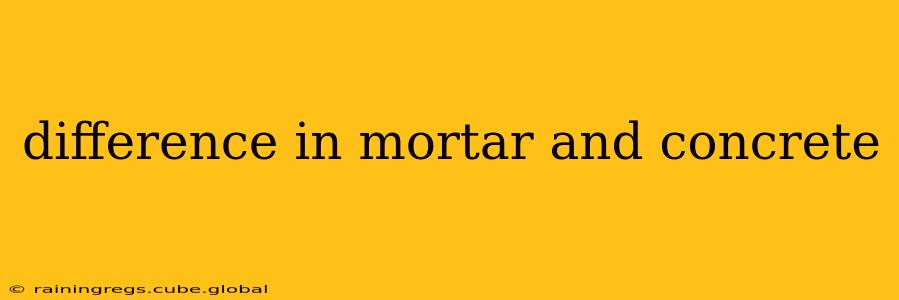Mortar and concrete are both fundamental construction materials, but they differ significantly in their composition, application, and properties. Understanding these differences is crucial for any construction project, whether you're a seasoned professional or a DIY enthusiast. This guide will delve into the core distinctions between these two essential building materials.
What is Mortar?
Mortar is a mixture of cement, sand, and water. Sometimes lime is added to improve workability and enhance its long-term durability. Its primary purpose is to bind building materials together, such as bricks, blocks, and stones. Think of it as the "glue" that holds a masonry structure together. Mortar is typically much weaker in compressive strength than concrete.
What is Concrete?
Concrete, on the other hand, is a composite material consisting of cement, aggregates (gravel, crushed stone, or recycled materials), sand, and water. The aggregates significantly increase its strength and bulk. Concrete is used for a vast array of applications, from foundations and sidewalks to structural elements like beams and columns. It's known for its high compressive strength, making it ideal for load-bearing applications.
Key Differences Summarized:
| Feature | Mortar | Concrete |
|---|---|---|
| Composition | Cement, sand, water (and sometimes lime) | Cement, aggregates, sand, water |
| Aggregates | No significant aggregates | Significant aggregates (gravel, crushed stone) |
| Strength | Lower compressive strength | Much higher compressive strength |
| Purpose | Binding masonry units together | Structural element, foundations, etc. |
| Workability | Typically more workable | Can be less workable, depending on mix |
| Application | Filling gaps between masonry units | Pouring into forms, placing in situ |
What are the main ingredients of mortar?
Mortar's primary components are cement, sand, and water. The cement provides the binding agent, the sand gives it body and bulk, and water activates the cement's hydraulic properties, allowing it to harden. Lime is often added as a fourth ingredient to improve its workability and enhance its long-term durability, particularly in harsh environments or when facing freeze-thaw cycles.
What are the main ingredients of concrete?
Concrete's main ingredients include cement, aggregates, sand, and water. Cement again acts as the binding agent. Aggregates (typically gravel or crushed stone) significantly increase the concrete's strength and reduce its overall cost. Sand fills the spaces between the larger aggregates, creating a denser, stronger mixture. Water, like in mortar, is essential to the chemical reaction that leads to hardening.
What are the uses of mortar?
Mortar is primarily used to bond masonry units together. This includes:
- Bricklaying: Joining bricks in walls, chimneys, and other structures.
- Blocklaying: Connecting concrete or cinder blocks.
- Stone Masonry: Securing stones in walls, pavements, and other applications.
- Repairing Masonry: Filling cracks and repairing damaged masonry structures.
What are the uses of concrete?
Concrete's versatility makes it a cornerstone material in modern construction. Its uses include:
- Foundations: Providing a solid base for buildings and other structures.
- Slabs: Creating floors, driveways, patios, and sidewalks.
- Structural Elements: Forming beams, columns, and other load-bearing components.
- Walls: Constructing retaining walls and other non-load-bearing walls.
- Decorative Applications: Creating countertops, architectural features, and decorative elements.
Can I use mortar instead of concrete?
No, you generally cannot use mortar instead of concrete for structural applications. Mortar's significantly lower compressive strength makes it unsuitable for load-bearing situations. Using mortar where concrete is required could lead to structural failure and serious safety risks.
This detailed comparison clarifies the distinct roles of mortar and concrete in the construction world. Remember to always select the appropriate material for the intended application to ensure safety and structural integrity.
